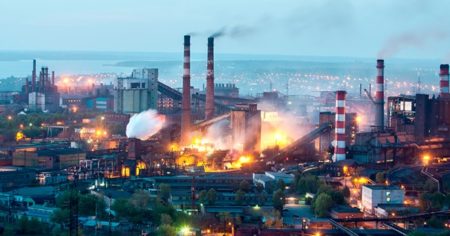24 September 2020
By Tony Rogerson
news@TheCork.ie
Of the entire range of harmful substances entering the atmosphere, one of the most important factors is dust emitted by enterprises of metallurgy and other heavy industries. The most dangerous for humans is fine (respirable) dust with a particle size of up to 10 microns, which is not effectively captured by existing cleaning devices and spreads in the atmosphere over long distances.
Air pollution by emissions from metallurgical enterprises changes the direction of dynamic processes in ecosystems, causes technogenic successions in vegetation and soil cover, and leads to a decrease in soil biodiversity and the biological activity of soils. Forest and meadow species are most sensitive to the impact of technogenic pollution. In contrast, weed and ruderal species can accumulate significant amounts of heavy metals (HM) in their organs and often increase their abundance in polluted areas.
What are the solutions?
The main way to increase the environmental safety of the atmosphere today is to reduce emissions by improving dust collection devices. Effective modernization of dust collection systems is constrained by the high cost of new devices and the lack of a scientifically sound assessment of the long-term environmental effect of the use of new equipment. Read more about the steel industry equipment and problems on metinvest.com.
The components of dust emissions
Almost all stages of technological processes of production of non-ferrous and rare metals are accompanied by the formation of dust, which is carried out by technological and ventilation gases. Sulfuric and sulfuric anhydrides, hydrogen chloride, chlorine, fluorine, and other processed raw materials are typical components of post-industrial dust. The amount of dust formed depends on the metallurgical process, its intensity, unit design, physicochemical characteristics of the components of the charge (size, strength, the composition of refractory metals and compounds, etc.), and many other factors.
When is dust formed?
Dust is formed especially intensively in the latest metallurgical processes, such as annealing and melting of concentrates in the fluidized bed and suspended state, sublimation processes, and others. For example, at rolling and slag distillation practically all extracted non-ferrous and rare metals (zinc, lead, cadmium, indium) are taken out with gases in the form of dust, and inefficient catching leads to considerable economic losses. It follows from the above that most of the associated components of raw materials (cadmium, germanium, thallium, selenium, and other metals with high volatility) pass into the dust.
The main methods of air purification
Under legal requirements in environmental protection, health, and labour protection, air purification measures at a metallurgical plant are mandatory. They dictate the use of modern, highly efficient technologies. All air purification equipment is divided into several types, differing in the method of chemical or physical exposure:
- Wet method using water and other liquids with the formation of sediment;
- Dry method exposure to physical forces and filtration;
- Chemical action using oxidation, reduction and sorption reactions;
- Electrical particle removal.
The technique is selected individually for each task. For instance, the blast furnace’s air purification means cleaning the gas to protect burners, air heaters, and recuperators from dust. The technique consists of several stages, including:
- Rough cleaning;
- Gas cooling;
- Fine cleaning.
First, large particles of iron dust are removed. The release of coarse fractions is prevented by using vertical blast-furnace dust collectors. A dust collector is a device that helps to clean the dust and purify the air. This piece of equipment has the shape of a cylinder in the middle and tapers to a conical top and bottom. It is equipped with a valve connected to the furnace gas outlets. There is a diffuser to reduce the flow rate. Dust particles settle, and the gas is directed for fine cleaning
It is wet gas cleaning that is most effective in metallurgy, and it is carried out using a set of equipment. The scheme is simple but effective. It consists of:
- Scrubber and Venturi pipes;
- Throttle group;
- Water separator.
An important element of the system is a ring-type pipeline with outlets sprayers. This makes it possible to cover the scrubber section with water evenly. As you can see, there are various methods of coping with the dust emissions.


